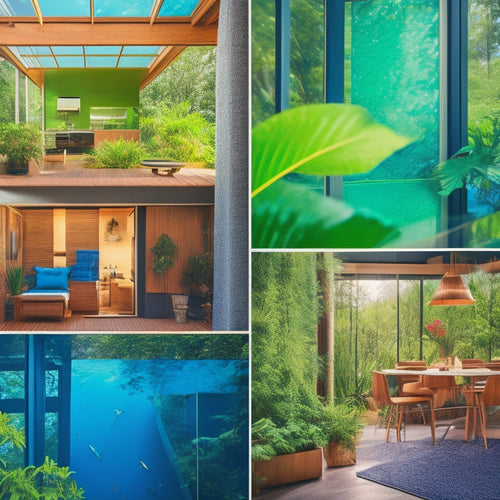Elegant and Eco-Friendly: Merging Style With Sustainability in Fashion
Share
Imagine you could elevate your wardrobe with pieces that are not only stylish but also kind to the planet. By choosing garments made from organic materials and supporting brands that prioritize ethical production, you can make a significant impact. Have you ever thought about how circular fashion principles or upcycling innovations could influence your fashion choices? As the industry shifts towards sustainability, you'll discover luxurious yet eco-conscious options that don't compromise on elegance. So, how can you seamlessly blend style with sustainability in your everyday attire?
Key Takeaways
- Opt for garments made from organic materials like organic cotton, hemp, and bamboo for both elegance and sustainability.
- Support ethical production by choosing brands that ensure fair wages and transparent sourcing practices.
- Embrace circular fashion by selecting items that prioritize textile recycling and waste reduction.
- Invest in sustainable luxury brands like Stella McCartney and Gucci's 'Gucci Equilibrium' initiative for eco-conscious style.
- Enhance your wardrobe with secondhand, vintage, and upcycled fashion to merge elegance with environmental responsibility.
Organic Materials
Organic materials are transforming the fashion industry by providing eco-friendly alternatives that don't compromise on style. Imagine commanding a room with garments made from the highest quality natural fibers, such as organic cotton, hemp, and bamboo. These materials not only offer unparalleled comfort and durability, but they also align perfectly with a sustainable lifestyle. You're not just wearing clothes; you're making a statement that reflects your commitment to both elegance and environmental stewardship.
Incorporating biodegradable dyes into your wardrobe further elevates your fashion game. These dyes break down naturally without leaving harmful residues, ensuring that your sartorial choices contribute to a healthier planet. It's a powerful move that signifies your awareness and leadership in adopting sustainable practices.
Biodegradable dyes offer a rich palette of colors, proving that style and sustainability can coexist seamlessly.
Ethical Production
Choosing garments made from organic materials is just one step; ensuring those clothes are ethically produced completes the circle of sustainable fashion. When you invest in fashion, you wield the power to demand fair wages and transparent sourcing. Ethical production isn't just a trend; it's a responsibility. By supporting brands that prioritize the well-being of their workers, you're not only championing human rights but also setting a standard for the entire industry.
Consider the impact of your choices. Brands that are transparent about their sourcing practices provide you with the assurance that every hand involved in making your garment is treated with respect and paid fairly. This transparency isn't just about moral high ground; it's about creating a ripple effect that encourages other brands to follow suit.
Embrace ethical production as a cornerstone of your fashion philosophy. Insist on knowing where and how your clothes are made. Demand that brands you support are committed to fair wages and transparent sourcing. By doing so, you're not only enhancing your wardrobe but also contributing to a more just and sustainable world. Your choices matter—use your influence wisely.
Circular Fashion
You can make a significant impact on the environment by embracing circular fashion.
By choosing garments made from sustainable materials and supporting brands that prioritize reducing textile waste, you're fostering a more eco-friendly wardrobe.
This approach not only champions sustainability but also guarantees that style and responsibility go hand in hand.
Reducing Textile Waste
In the fashion world, embracing circular fashion practices is crucial to reduce textile waste and create a more sustainable industry. You have the power to revolutionize waste management by prioritizing textile recycling. By doing so, you not only minimize waste but also breathe new life into discarded materials. This approach transforms what was once considered waste into valuable resources, driving a powerful shift in how fashion operates.
Imagine a world where every piece of fabric you discard finds its way back into the fashion ecosystem, reducing the demand for raw materials and lowering the industry's carbon footprint. By adopting circular fashion methods, you make sure that textiles are reused, repurposed, and recycled, thereby extending their lifecycle. This isn't just about being eco-friendly; it's about exercising control and influence over a sustainable future.
Take charge by supporting brands that prioritize textile recycling and integrate waste management strategies into their production processes. Your choices hold weight and can drive a broader industry change. When you advocate for circular fashion, you champion a method that aligns elegance with sustainability, proving that style and environmental responsibility can coexist harmoniously.
Sustainable Material Choices
Shifting from waste management to innovative material choices, sustainable fabrics like organic cotton, Tencel, and recycled polyester offer stylish alternatives that greatly reduce environmental impact. By opting for these materials, you're not just making a fashion statement; you're championing a movement that prioritizes our planet's well-being.
Biodegradable textiles, for instance, break down naturally, leaving no harmful residues. This means that your wardrobe choices can seamlessly align with your eco-conscious values.
Hemp fibers, another remarkable option, are known for their durability and minimal need for pesticides and water. By integrating hemp into your fashion repertoire, you're embracing a fabric that's both robust and remarkably sustainable. Imagine the power in wearing garments that don't just look good but also make a positive environmental impact.
Recycled polyester, derived from plastic bottles, transforms waste into wearable art. By choosing this material, you're directly reducing plastic pollution. It's a compelling way to merge style with sustainability, proving that luxury and responsibility can coexist. These sustainable material choices put you at the forefront of fashion innovation, showcasing your commitment to a smarter, cleaner future.
Upcycling Innovations
When you embrace upcycling innovations, you're transforming waste into stunning fashion statements. Creative reuse techniques allow designers to turn discarded materials into unique, stylish pieces.
Transforming Waste Into Fashion
Upcycling innovations are revolutionizing the fashion industry by turning discarded materials into stylish, high-quality garments. Imagine the power you hold by choosing pieces that not only make a fashion statement but also champion sustainability. Through advanced waste management and recycling programs, designers are harnessing the potential of what was once deemed useless. You're no longer just a consumer; you're a curator of eco-friendly elegance.
By embracing upcycled fashion, you contribute to reducing the environmental footprint of the industry. Fast fashion's wastefulness is a relic of the past when you opt for garments crafted from repurposed materials. These innovations guarantee that every piece you wear tells a story of transformation and resilience. You're not just wearing clothes; you're wearing a display of ingenuity and responsibility.
Moreover, upcycled fashion isn't just about sustainability; it's about exclusivity and power. Each item is unique, often limited in production, making your wardrobe as distinctive as your ambitions. When you choose upcycled garments, you're making a bold statement. You're saying you care about the planet, but you won't compromise on style. In a world where sustainability is the new luxury, you're at the forefront, leading by example.
Creative Reuse Techniques
By creatively repurposing materials like old denim, plastic bottles, and factory offcuts, designers are crafting innovative, sustainable fashion that's both stylish and eco-conscious. Repurposing denim, for example, transforms discarded jeans into trendy jackets or bags, showcasing that sustainability can be synonymous with sophistication. Fabric collage is another brilliant technique, where remnants from various materials are pieced together to create unique, eye-catching designs.
These upcycling innovations not only reduce waste but also add a layer of exclusivity to fashion pieces, making them highly desirable. Imagine the power you wield when you wear a garment that's not only fashion-forward but also environmentally responsible. Here's a glimpse into some transformative techniques:
| Material | Upcycling Technique |
|---|---|
| Old Denim | Repurposed Jackets |
| Plastic Bottles | Recycled Fabric |
| Factory Offcuts | Fabric Collage |
| Vintage Textiles | Patchwork Clothing |
| Discarded Leather | Upcycled Accessories |
These methods prove that sustainability doesn't mean sacrificing style. By supporting brands that prioritize these techniques, you're not only making a fashion statement but also contributing to a more sustainable future. Elevate your wardrobe and wield your influence by embracing these eco-friendly innovations.
Eco-Friendly Fabrics
Eco-friendly fabrics, such as organic cotton and bamboo, offer a stylish yet sustainable choice for conscientious consumers. By choosing biodegradable textiles, you can make a powerful statement about your commitment to the environment without sacrificing style. Organic cotton, free from harmful pesticides, and bamboo, known for its rapid growth and minimal water usage, are just the beginning.
Consider the benefits of hemp fabric, which isn't only durable but also naturally resistant to pests, requiring fewer resources to cultivate. When you opt for these eco-friendly materials, you're investing in a future where fashion doesn't come at the planet's expense.
Here's a closer look at the advantages:
-
Biodegradability: These fabrics break down naturally, significantly reducing landfill waste.
-
Minimal Chemical Use: Organic cotton and hemp are grown without synthetic pesticides, protecting soil and water quality.
-
Energy Efficiency: Bamboo and hemp require less energy to process, lowering your carbon footprint.
-
Durability: Hemp fabric is incredibly strong, ensuring your garments last longer.
-
Skin-Friendly: These natural fibers are gentle on your skin, free from harsh chemicals.
Sustainable Luxury Brands
As you embrace eco-friendly fabrics, you'll find that several luxury brands are leading the way in merging high fashion with sustainable practices. High-end names like Stella McCartney and Gucci have committed to eco-conscious branding, ensuring their production processes are as green as their designs are glamorous.
Stella McCartney, for instance, uses organic cotton and recycled materials, setting a benchmark for sustainability without sacrificing style.
Gucci's approach to eco-conscious branding includes their 'Gucci Equilibrium' initiative, which focuses on reducing their environmental footprint and promoting sustainable luxury. By choosing these brands, you're not just purchasing a product; you're investing in a vision of a more sustainable future.
Luxury resale is another growing trend that aligns perfectly with this ethos. Platforms like The RealReal and Vestiaire Collective offer you the chance to own high-end fashion pieces that have a smaller environmental impact. These platforms not only extend the life cycle of luxury items but also make eco-friendly luxury accessible.
Zero-Waste Designs
In your pursuit of a truly sustainable wardrobe, zero-waste designs stand out as an innovative and impactful approach to minimizing fashion waste. This method involves optimizing patterns and ensuring every inch of fabric is utilized, leaving no scraps behind.
By embracing pattern efficiency and design optimization, you're not just reducing waste; you're transforming the very fabric of your style into a powerful statement of eco-awareness.
Picture your wardrobe reflecting the pinnacle of sustainable fashion with:
- Garments tailored using every bit of fabric, leaving no waste.
- Designs that challenge the conventional boundaries of creativity.
- Pieces that speak volumes about your commitment to the planet.
- A fashion footprint that's as minimal as possible.
- An elevated style that merges elegance with environmental consciousness.
Green Fashion Trends
Today, fashion trends are evolving to prioritize sustainability, offering you the opportunity to stay stylish while making environmentally conscious choices. Embracing green fashion trends not only elevates your wardrobe but also showcases your commitment to the environment.
One powerful trend is secondhand shopping, where you find unique, high-quality pieces while reducing waste. Vintage collections are making a strong comeback, offering timeless style with a reduced environmental footprint. By opting for these, you're not just following a trend, but setting a standard.
Here's a snapshot of what's currently hot in green fashion:
| Trend | Benefits | How to Incorporate |
|---|---|---|
| Secondhand Shopping | Reduces waste, saves money | Explore thrift stores, online platforms |
| Vintage Collections | Timeless style, sustainable choice | Invest in classic, durable pieces |
| Upcycled Fashion | Creative, unique items | Support brands that upcycle materials |
Frequently Asked Questions
How Can I Start Building a Sustainable Wardrobe on a Budget?
Start building a sustainable wardrobe on a budget by thrift shopping and participating in clothing swaps. You're not only saving money but also making a powerful, eco-friendly choice that reflects your style and commitment to sustainability.
What Are Some Common Misconceptions About Sustainable Fashion?
You might think all sustainable fashion is genuinely eco-friendly, but greenwashing tactics often deceive consumers. Ethical transparency is essential; always research brands to make sure their claims are genuine and not just marketing ploys.
How Do I Know if a Brand Is Genuinely Eco-Friendly?
To know if a brand is genuinely eco-friendly, you should scrutinize their transparency about ethical sourcing, and watch for greenwashing tactics. Investigate their certifications and supply chain details to confirm they truly prioritize sustainability.
Are There Any Specific Certifications to Look for in Sustainable Fashion?
When evaluating sustainable fashion, look for certification standards like GOTS, Fair Trade, and OEKO-TEX. These eco labels guarantee eco-friendly processes and ethical practices, empowering you to make informed, impactful choices in your wardrobe.
Can Sustainable Fashion Still Be Trendy and Stylish?
Absolutely, sustainable fashion can be trendy and stylish. By embracing eco-friendly fabrics and upcycling trends, you can command attention with outfits that are both cutting-edge and environmentally conscious. Your choices will set you apart as a leader.
Related Posts
-

Green Home Improvements Using Solar Power
Investing in solar power alters your home into a sustainable haven while slashing energy costs. You can greatly reduc...
-

Innovative Sustainable Materials for Energy-Efficient Homes
Innovative sustainable materials enable you to create energy-efficient homes while promoting environmental responsibi...
-

Affordable Solar Panels for Home Use
Affordable solar panels offer you a smart way to cut down on energy costs while promoting sustainability. With govern...


